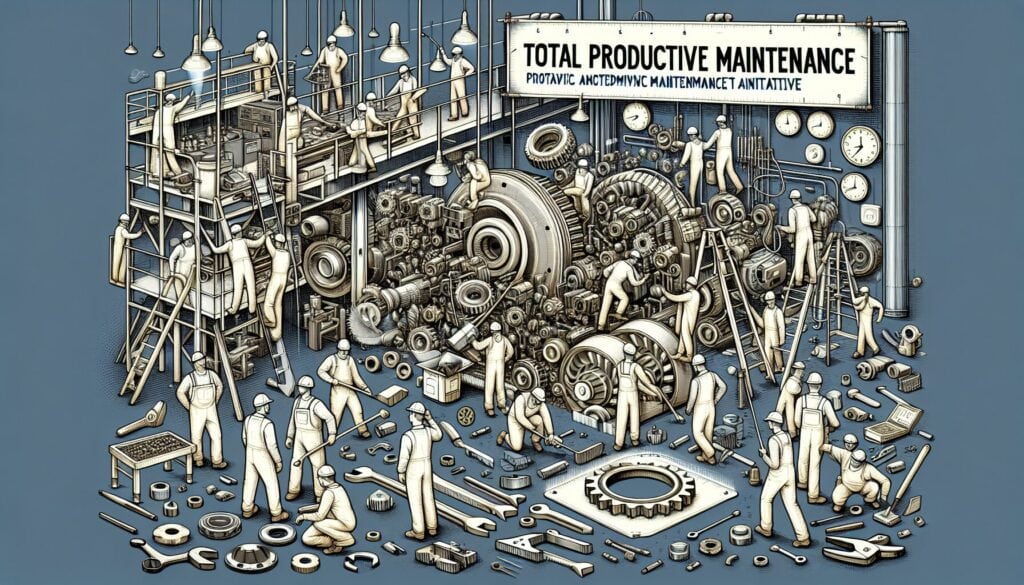Ottenere una produzione quasi perfetta (nessun guasto, nessun piccolo arresto o rallentamento, nessun difetto e nessun incidente) attraverso un approccio proattivo e olistico che coinvolga tutti i dipendenti nella manutenzione delle attrezzature.
- Metodologie: Clienti e marketing, Ideazione, Progettazione del prodotto
Manutenzione Produttiva Totale (TPM)

Manutenzione Produttiva Totale (TPM)
- Miglioramento continuo, Produzione snella, Produzione snella, Manutenzione, Efficacia complessiva delle apparecchiature (OEE), Miglioramento dei processi, Produttività, Gestione della qualità, Sicurezza
Obiettivo:
Come si usa:
- Un sistema per mantenere e migliorare l'integrità dei sistemi di produzione e di qualità attraverso macchine, attrezzature, processi e dipendenti che aggiungono valore commerciale a un'organizzazione. Si sottolinea l'importanza di dare agli operatori la possibilità di contribuire alla manutenzione delle proprie attrezzature (manutenzione autonoma).
Professionisti
- Aumenta l'efficacia (OEE) e l'affidabilità delle apparecchiature; riduce i tempi di fermo e i costi di manutenzione; migliora la sicurezza e la qualità dei prodotti; aumenta il coinvolgimento e il morale dei dipendenti.
Contro
- Richiede un cambiamento culturale significativo e un impegno a lungo termine; può essere costoso e lungo da implementare completamente; richiede una formazione approfondita per gli operatori e il personale di manutenzione.
Categorie:
- Ingegneria, Risorse umane, Lean Sigma, Produzione, Qualità
Ideale per:
- Massimizzare l'efficacia delle apparecchiature e durata attraverso una strategia di manutenzione completa e proattiva che coinvolge tutti i dipendenti.
La manutenzione produttiva totale (TPM) è ampiamente applicabile in vari settori, in particolare in quello manifatturiero, automobilistico e alimentare, dove i tempi di attività delle apparecchiature sono essenziali per mantenere l'efficienza e la qualità della produzione. Nel contesto delle fasi di progetto, la TPM può essere integrata durante le fasi di progettazione e sviluppo, dove i contributi degli operatori possono portare a progetti di apparecchiature più manutenibili che migliorano le prestazioni operative. Spesso coinvolge team interfunzionali che comprendono il personale di manutenzione, il personale di produzione e gli esperti di controllo qualità che collaborano per identificare le aree di miglioramento e implementare misure preventive. Avviata dalla direzione, la TPM si basa sul coinvolgimento di tutti i dipendenti, incoraggiandoli ad assumersi la responsabilità delle macchine che utilizzano, creando così una cultura del miglioramento continuo e della risoluzione dei problemi. Per esempio, nell'industria automobilistica, l'adozione dei principi della TPM ha guidato a riduzioni significative dei guasti alle apparecchiature e dei tempi di fermo non programmati, consentendo alle aziende di migliorare l'efficienza complessiva delle apparecchiature (OEE) monitorando attentamente le metriche di prestazione e prendendo decisioni basate sui dati. I dipendenti che partecipano alle iniziative TPM riportano anche una maggiore soddisfazione lavorativa e un senso di appartenenza, che si traducono in un miglioramento del morale e della produttività. Questa metodologia non si limita alle attività di manutenzione, ma si concentra su un approccio olistico per migliorare le capacità dei processi, assicurando che le organizzazioni possano adattarsi rapidamente ai cambiamenti della domanda o dei metodi di produzione, mantenendo elevati standard di sicurezza e qualità.
Fasi chiave di questa metodologia
- Eseguire una valutazione iniziale delle apparecchiature per identificare le condizioni attuali e le esigenze di manutenzione.
- Implementare la manutenzione autonoma addestrando gli operatori a eseguire controlli di routine e piccole riparazioni.
- Stabilire programmi di manutenzione regolari per le attività di manutenzione preventiva e predittiva.
- Standardizzare le procedure operative per garantire prestazioni coerenti e ridurre la variabilità.
- Integrare i principi TPM nei processi di lavoro quotidiani per un miglioramento continuo.
- Condurre l'analisi delle cause dei guasti e implementare le azioni correttive per evitare che si ripetano.
- Coinvolgere tutti i dipendenti nelle attività TPM per promuovere una cultura di responsabilità condivisa.
- Utilizzare strumenti di gestione visiva per monitorare i progressi della manutenzione e lo stato delle apparecchiature.
Suggerimenti per i professionisti
- Implementare un programma di formazione strutturato per gli operatori in modo da riconoscere i primi segnali di problemi alle apparecchiature, migliorando l'intervento precoce e le misure preventive.
- Utilizzate l'analisi dei dati per il monitoraggio in tempo reale, consentendo la manutenzione predittiva e la programmazione ottimizzata per ridurre al minimo le interruzioni.
- Incoraggiare i team interfunzionali a valutare e analizzare le prestazioni delle apparecchiature, garantendo input diversi e soluzioni innovative per un miglioramento continuo.
Leggere e confrontare diverse metodologie, raccomandiamo il
> Ampio archivio di metodologie <
insieme ad altre 400 metodologie.
I vostri commenti su questa metodologia o ulteriori informazioni sono benvenuti su sezione commenti qui sotto ↓ , così come tutte le idee o i link relativi all'ingegneria.
Contesto storico
1962
1970
1972
1980
1980
1986
1986
1960
1963
1970
1980
1980
1980
1986
1987
(se la data non è nota o non è rilevante, ad esempio "meccanica dei fluidi", viene fornita una stima approssimativa della sua notevole comparsa)















Post correlati
Questionari sul disagio muscoloscheletrico
Test multivariati (MVT)
Analisi di regressione multipla
Sistemi di cattura del movimento
Metodo MoSCoW
Test mediano dell'umore